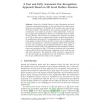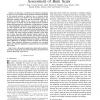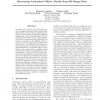24 search results - page 3 / 5 » Sherlock: automatically locating objects for humans |
CIKM
2005
Springer
14 years 1 months ago
2005
Springer
In this paper we address the problem of unsupervised Web data extraction. We show that unsupervised Web data extraction becomes feasible when supposing pages that are made up of r...
ACIVS
2008
Springer
13 years 9 months ago
2008
Springer
Sensitivity of global features to pose, illumination and scale variations encouraged researchers to use local features for object representation and recognition. Availability of 3D...
TMI
1998
13 years 7 months ago
1998
—In this paper a method for the objective assessment of burn scars is proposed. The quantitative measures developed in this research provide an objective way to calculate elastic...
EUC
2007
Springer
13 years 9 months ago
2007
Springer
In this paper we present a system, called U-interactive, that provides spontaneous interactions between human and surrounding objects in heterogenous ubiquitous computing environme...
UAI
2004
13 years 8 months ago
2004
We address the problem of unsupervised learning of complex articulated object models from 3D range data. We describe an algorithm whose input is a set of meshes corresponding to d...



